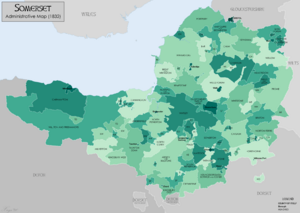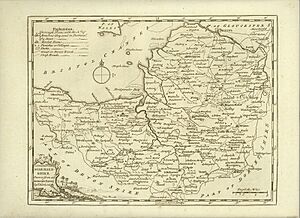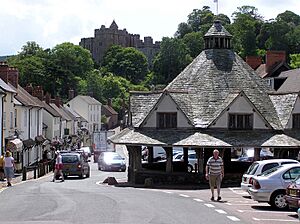History of Somerset facts for kids
Somerset is a historic county in the south west of England. People have lived here since ancient times. We know this from tools like hand axes and flint points. These date back to the Palaeolithic and Mesolithic eras. There are also burial mounds, hill forts, and other artefacts. These come from the Neolithic, Bronze Age, and Iron Ages. The oldest known human-made road in Great Britain is the Sweet Track. It was built with wooden planks across the Somerset Levels around 3900 BCE.
After the Roman Empire came to southern Britain, lead and silver mining grew. This happened in the Mendip Hills. It helped local businesses and trade. Bath became a big Roman fort and city. You can still see its remains today. During the Early Medieval period, Somerset saw many battles. First, the Anglo-Saxons fought the Britons. Later, they fought the Danes. During this time, different kings of Wessex ruled. Then, kings of England took over. After the Normans won in 1066, castles were built in Somerset.
More people and towns grew in the Tudor and later times. Farming and coal mining became bigger until the 18th century. Other industries became smaller during the Industrial Revolution. In modern times, the population has grown a lot. This is especially true in seaside towns like Weston-super-Mare. Farming is still a big business. However, it employs fewer people because of machines. Light industries are found in towns like Bridgwater and Yeovil. Taunton and Shepton Mallet make cider. But there are fewer apple orchards than before.
Contents
Ancient Times: Stone Age Hunters
Early Humans in Somerset
Long, long ago, during the Palaeolithic and Mesolithic periods, hunter-gatherers lived in Somerset. We have found flint tools in a quarry at Westbury-sub-Mendip. These tools suggest that an early human ancestor, perhaps Homo heidelbergensis, lived here. This was about 500,000 years ago! Some experts are still debating if these tools were definitely made by humans.
Modern humans, called Homo sapiens sapiens, arrived in Somerset later. This was during the Early Upper Palaeolithic period. There is proof that people lived in four Mendip caves. This was between 35,000 and 30,000 years ago. During the coldest part of the last ice age, Somerset was probably empty. It was too cold, like a tundra.
Ice Age Survivors and Early Farmers
Evidence from Gough's Cave shows human bones from about 12,500 years ago. Cheddar Man is the name for the oldest complete human skeleton in Britain. He was found in Gough's Cave in Cheddar Gorge. His remains are from about 7150 BC. It looks like he died a violent death.
Somerset was one of the first places in England to be settled after the last ice age ended. This was around 8000 BC. Mesolithic hunter-gatherers lived in Somerset from about 6000 BCE. We have found Mesolithic tools in over 70 places. Mendip caves were used as burial sites. For example, 50 to 100 skeletons were found in Aveline's Hole. Around 3500 BCE, during the Neolithic era, people started farming.
Ancient Roads and Settlements
After the last ice age, the Bristol Channel was dry land. But then sea levels rose, especially between 1220 and 900 BC. This caused big changes to the coast. The Somerset Levels became flooded. But dry spots like Glastonbury and Brent Knoll have a long history of people living there. Mesolithic hunters used these areas.
Somerset has ancient burial mounds like Stoney Littleton Long Barrow. It also has stone rows like the circles at Stanton Drew and Priddy. There are also old settlement sites. The Sweet Track is one of Britain's oldest human-made roads. It was built with wooden planks across the Somerset Levels in 3900 BC. It even followed the path of an older track called the Post Track.
Bronze and Iron Ages: New Tools and Tribes
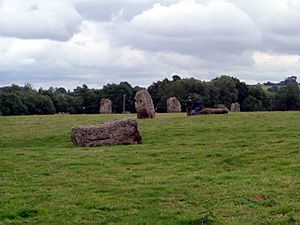
Farming and Metalworking
People lived on Exmoor from Mesolithic times onwards. In the Neolithic period, people began to farm. They managed animals and grew crops. They cleared forests to make farms. Before this, they were just hunter-gatherers. It is also likely that people started mining and melting ores. They used these metals to make tools, weapons, and jewelry. This began in the late Neolithic and continued into the Bronze and Iron Ages.
The caves of the Mendip Hills were settled during the Neolithic period. They have many archaeological sites, like those at Cheddar Gorge.
Hill Forts and Ancient Tribes
There are many Iron Age hill forts in Somerset. These were later used again in the Dark Ages. Examples include Cadbury Castle, Worlebury Camp, and Ham Hill. The age of the henge monument at Stanton Drew stone circles is unknown. But it is thought to be from the Neolithic period. Mining on the Mendip Hills goes back to the late Bronze Age. This is when new metalworking technologies appeared.
The Iron Age tribes in Somerset were the Dobunni in the north. The Durotriges were in the south. The Dumnonii were in west Somerset. All three tribes had a Celtic culture and language. Celtic gods were worshipped at the temple of Sulis in Bath. Iron Age sites on the Quantock Hills include large hill forts. These are at Dowsborough and Ruborough.
Roman Rule: Cities and Mines
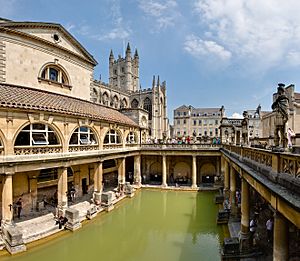
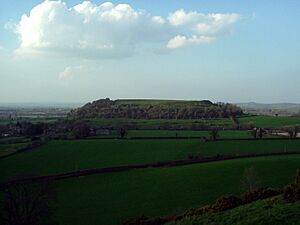
Somerset was part of the Roman Empire from 47 AD to about 409 AD. The Romans invaded from the south-east. The Second Legion Augusta, led by future emperor Vespasian, captured hill forts. These included Ham Hill and Cadbury Castle.
The Romans were interested in the Mendip Hills. They wanted to mine lead and silver there. Forts were built at Bath and Ilchester. The lead and silver mines at Charterhouse were run by the military. The Romans also built a defensive road called the Fosse Way. This road went through Bath, Shepton Mallet, and Ilchester.
Small towns and trading ports were set up. Examples include Camerton and Combwich. In the eastern part of the county, many villas were built. These villas have given us important mosaics and artifacts. Cemeteries have been found outside Roman towns. There was also salt production on the Somerset Levels. Quarrying took place near Bath, where the Roman Baths are located.
Excavations before Chew Valley Lake was flooded found Roman remains. These showed farming and industry from the 1st to 3rd centuries AD. A large villa at Chew Park was found. Wooden writing tablets with ink were discovered there. In 2001, the West Bagborough Hoard was found. It contained 681 Roman silver coins from the 4th century. In 2010, the Frome Hoard was discovered. It was one of the largest Roman coin hoards ever found in Britain, with 52,500 coins.
After the Romans: Saxon Arrival
Changing Borders and Kingdoms
This period is from about 409 AD until the Saxons took political control. This mainly happened in the late 7th century. At first, the Britons in Somerset continued much as they had under the Romans. The Western Wansdyke was likely built in the 5th or 6th century. This area became the border between the Romano-British Celts and the West Saxons. This happened after the Battle of Deorham in 577 AD. The ditch of the Wansdyke is on the north side. This suggests the Celts used it to defend against Saxons coming from the Thames Valley.
The Saxon advance from the east was slowed by battles. For example, the siege of Badon Mons Badonicus might have been near Bath. During the 5th, 6th, and 7th centuries, Somerset was likely part of different kingdoms. These included Dumnonia, the land of the Durotriges, and the Dobunni. The boundaries between these are mostly unknown.
Life and Religion in Sub-Roman Somerset
There is evidence of important people at hill forts like Cadbury Castle. For example, imported pottery has been found. Cemeteries are an important source of information. Large ones have been found in Somerset, like at Cannington. This cemetery was used from the Roman to the Saxon period. The towns of Somerset were not used much during this time. But farming continued at the villa sites and Romano-British villages.
The language spoken was likely Southwestern Brythonic. Only one or two inscribed stones from this period survive in Somerset. Some place names in Somerset seem to be Celtic. River names, like Parrett, might be Celtic or even older. People in Somerset were likely Christian during this time. Some church sites in Somerset are thought to be from this period.
Most of what we know comes from Gildas's On the Ruin of Britain. The first fort in Taunton was started by King Ine of Wessex around 710 AD. But it was destroyed 12 years later.
Early Medieval: Kings and Vikings
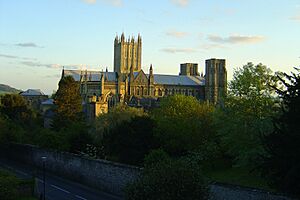
This period runs from the late 7th century to 1066. For some time, England was under Danish control. Somerset was a frontier between the Saxons and the Romano-British Celts. The Saxons conquered Bath in 577. The border was probably along the Wansdyke.
Saxon Rule and Viking Raids
Saxon rule was strengthened under King Ine. He built a fort at Taunton, which his wife later destroyed. Ine fought against Geraint in 710. In 705, the diocese of Sherborne was formed. Saxon kings gave land in Somerset by charter. Somerset was originally part of Wessex. Later, it became a separate "shire" called Somersetshire. Mints were set up in places like Watchet.
Somerset played a big role in stopping the Danes in the 9th century. In 845, the men of Somersetshire, led by Alderman Eanwulf, defeated the Danish army. This was the first time the name Somersæte was used. In 878, King Alfred the Great hid in the Somerset marshes. He built a fort at Athelney. From there, Alfred organized a resistance. He used local militias from Somerset, Wiltshire, and Hampshire.
Viking raids happened in 987 and 997 at Watchet. King Alfred had to hide from the Danes at Athelney. He later defeated them at the Battle of Ethandun in 878. This battle is usually thought to be near Edington, Wiltshire. But it might have been at Edington in Somerset. Alfred built a series of forts and lookout posts. These were linked by a military road, or Herepath. This helped his army track Viking movements. A peace treaty with the Danes was signed at Wedmore. The Danish king Guthrum the Old was baptized at Aller.
Monasteries and Royal Palaces
Burhs (fortified places) were set up by 919, like Lyng. The Alfred Jewel was found in 1693 at Petherton Park. It is a beautiful object made of gold and enamel. It is believed to have belonged to Alfred the Great. It was probably the handle for a pointer used for reading books.
Monasteries and minster churches were built all over Somerset. There was a royal palace at Cheddar. Kings visited places like Somerton, Bath, Glastonbury, and Frome. Farming grew during this period.
Before the Norman Conquest, Godwin, Earl of Wessex, and his family controlled Somerset. After the Norman Conquest, the county was divided into 700 fiefs. Large areas were owned by the crown. Forts like Dunster Castle were used for control and defense.
Later Medieval: Castles and Black Death
This period is from 1066 to about 1500. After the Normans defeated the Saxons in 1066, new lords built castles in Somerset. Examples include Dunster. The manors were given to followers of William the Conqueror.
Life in Medieval Somerset
The Domesday Book from 1086 gives us a good picture of the county. The total population was about 13,399 households. With families, this might have been around 67,000 people. Farming seemed to do well for the next 300 years. But it was badly affected by the Black Death. This plague arrived in Dorset in 1348 and quickly spread through Somerset. It caused many deaths, perhaps as much as 50% in some places. It came back several times. This changed how feudal practices worked because there were fewer workers.
More land was reclaimed from the marshy Somerset Levels. This was largely thanks to monasteries. Crafts and industries also grew. The Somerset wool industry was one of the biggest in England. "New towns" were founded, but they were not very successful. Coal mining in the Mendips was important. Quarrying also took place near Bath.
Powerful Church and Strong Castles
Towns grew, often helped by monasteries. Fairs also started. The church was very powerful, especially Glastonbury Abbey. After their church burned down, monks there "found" the tomb of "King Arthur." This helped them rebuild their church. Over 20 monasteries were in Somerset. Many parish churches were rebuilt.
Between 1107 and 1129, William Giffard changed the bishop's hall in Taunton into Taunton Castle. Bridgwater Castle was built in 1202. It was destroyed in 1645 during the English Civil War.
During the Middle Ages, sheep farming for wool became very important on Exmoor. The wool was spun on farms. Merchants collected it to be woven and finished in towns like Dunster. Land started to be enclosed. From the 17th century, larger estates grew. This led to big, regular-shaped fields.
The River Parrett was used to transport Hamstone from Ham Hill. Bridgwater became a major port in 1348. The river was navigable for large vessels up to Bridgwater. Smaller barges could go further upstream to Langport.
Early Modern: Rebellions and Industry
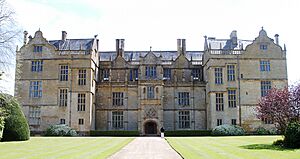
This period is from about 1500 to 1800. In the 1530s, the monasteries were closed down. Their lands were bought from the king by important families in Somerset. By 1539, Glastonbury Abbey was the only monastery left. Its abbot, Richard Whiting, was arrested and executed.
Farming, Houses, and Floods
From the Tudor to the Georgian times, farming improved. This led to more people. Large country houses were built, like Hinton St George and Montacute House.
The Bristol Channel floods of 1607 affected much of the Somerset Levels. The water was up to 8 feet above sea level. In 1625, a House of Correction was set up in Shepton Mallet. Today, HMP Shepton Mallet is England's oldest prison still in use.
Civil War and Rebellions
During the English Civil War, Somerset mostly supported Parliament. But Dunster was a Royalist stronghold. Important battles happened here, like the Battle of Lansdowne in 1643. The Battle of Langport in 1645 was also fought in Somerset. Castles were destroyed after the war to stop them from being used again.
In 1685, the Duke of Monmouth led the Monmouth Rebellion. People from Somerset fought against James II. The rebels were defeated in the Battle of Sedgemoor at Westonzoyland. This was the last battle fought on English soil. The Bloody Assizes followed. Many rebels were sentenced to death or sent away.
New Industries and Canals
The Society of Friends (Quakers) started in Street in the mid-17th century. The Clark family, Quakers, started a business there. They made sheepskin rugs, then woollen slippers, and later boots and shoes. C&J Clark still has its headquarters in Street. In 1993, old factory buildings became Clarks Village, a shopping outlet.
The 18th century was peaceful but industries declined. The Industrial Revolution in other parts of England ended most of Somerset's home-based industries. But farming continued to do well. The Bath and West of England Agricultural Society was founded in 1777 to improve farming methods.
Arthur Wellesley became the Duke of Wellington. His title came from the town of Wellington. A large monument, the Wellington Monument, stands on a nearby hill.
In north Somerset, coal mining was important. Canals were built to transport coal. These included the Somerset Coal Canal and the Bridgwater and Taunton Canal.
Late Modern: Railways, Wars, and Parks
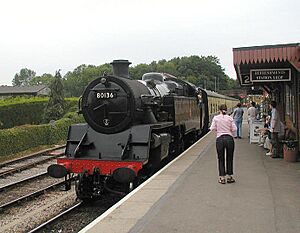
The 19th century brought better roads, canals, and railways to Somerset. Canals were useful for a short time. Now, they are used for fun. Railways were taken over by the government after the Second World War. Many smaller lines were closed in 1965. Some were reopened as "heritage" lines.
In 1889, Somerset County Council was created. The population of Somerset has grown since 1800. It was 274,000 then. By 1951, it was 551,000. Seaside towns like Weston-super-Mare grew a lot.
Innovations and World Wars
Chard claims to be where powered flight began. In 1848, John Stringfellow showed that engine-powered flight was possible. North Petherton was the first town in England lit by acetylene gas in 1906.
Around the 1860s, a pier and a deep-water dock were built at Portishead. This was for large ships. Portishead power stations were built next to the dock. They generated electricity. Industrial activities stopped at the dock when the power stations closed. The dock is now a marina and homes.
During the First World War, hundreds of Somerset soldiers died. War memorials were put up in most towns and villages. There were also deaths in the Second World War. Somerset was a base for troops preparing for the 1944 D-Day landings. The Royal Ordnance Factory ROF Bridgwater was built during World War II. It made explosives. The Taunton Stop Line was set up to stop a possible German invasion. You can still see its pill boxes. Decoy towns were built to trick enemy bombers. Prisoner of War camps were in places like Norton Fitzwarren and Wells. Several airfields were built or used.
National Parks and Modern Somerset
Exmoor became one of the first British National Parks in 1954. The Quantock Hills were named an Area of Outstanding Natural Beauty (AONB) in 1956. The Mendip Hills became an AONB in 1972.
Hinkley Point A nuclear power station operated until 2000. Hinkley Point B generates 1250 MW of electricity. A new power station, Hinkley Point C, is planned.
Today, Somerset has two small cities: Bath and Wells. It also has small towns. Tourism is a big source of jobs along the coast. It is also important in Bath and Cheddar. Other attractions include Exmoor, West Somerset Railway, Haynes Motor Museum, and the Fleet Air Arm Museum. Many churches and properties owned by the National Trust and English Heritage are also popular.
Farming is still a major business. But it employs fewer people due to machines. Light industries are in towns like Bridgwater and Yeovil. Taunton and Shepton Mallet make cider.
In 1974, the county of Avon was created. The northern part of Somerset was removed from Somerset County Council. When Avon was abolished in 1996, these areas became "North Somerset" and "Bath and North East Somerset".
See also
- Somerset
- Somerset Victoria County History
- Category:Hill forts in Somerset
- Category:History of Somerset
- Geology of Somerset
- History of England
- Timeline of the Anglo-Saxon invasion and takeover of Britain.
- List of places in Somerset
- List of Sites of Special Scientific Interest in Somerset
- William Fitz Reynold


